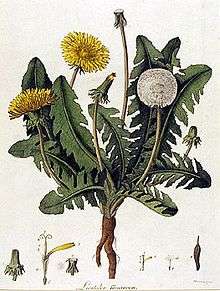William Kilburn

Dandelion
William Kilburn (1745–1818) was an illustrator for William Curtis' Flora Londinensis, as well as a leading designer and printer of calico. A few hundred originals of his water colour designs make up the Kilburn Album, housed at the Victoria and Albert Museum in London.[1]
William Kilburn was the son of a Dublin architect and was an apprentice to a calico printer, but spent his spare time engraving and sketching. He moved to Bermondsey after his father's death, and found living quarters near Curtis's nursery. Within a short while his skills were being used in the Flora Londinensis. He soon returned to calico printing, becoming financially successful.
Kilburn was the chief petitioner in March 1787, requesting Parliament for design copyright protection in the textile industry. At that time Kilburn was a calico printer at Wallington in Surrey. Ralph Yates, who was a London warehouseman, regularly sold Kilburn's designs to the firm of Peel & Co. in Bury in Lancashire, who would copy the design and produce a cheaper fabric that appeared in shops within a few days. Consequently the House of Commons proposed a Bill to control the plagiarism, a step meeting furious objections from Carlisle, Aberdeen, Manchester and Lancashire, who felt that their trade would collapse. The bill was passed in May 1787 "An Act for the Encouragement of the Arts of designing and printing Linens, Cottons, Callicoes and Muslins by vesting the Properties thereof in the Designers, Printers, Proprietors for a limited Time." This "limited Time" was a period of two months from the date of first publishing.[2] Many of Kilburn's works are available for viewing at The Victoria and Albert Museum, in South Kensington, London. An archive of Kilburn patterns are also available from the online V&A archives.
References
- ↑ "Alistair Kilburn, Artist - HOME PAGE".
- ↑ Longfield, Ada K. (1 January 1953). "William Kilburn and the Earliest Copyright Acts for Cotton Printing Designs". The Burlington Magazine. 95 (604): 230–233. JSTOR 871159.
